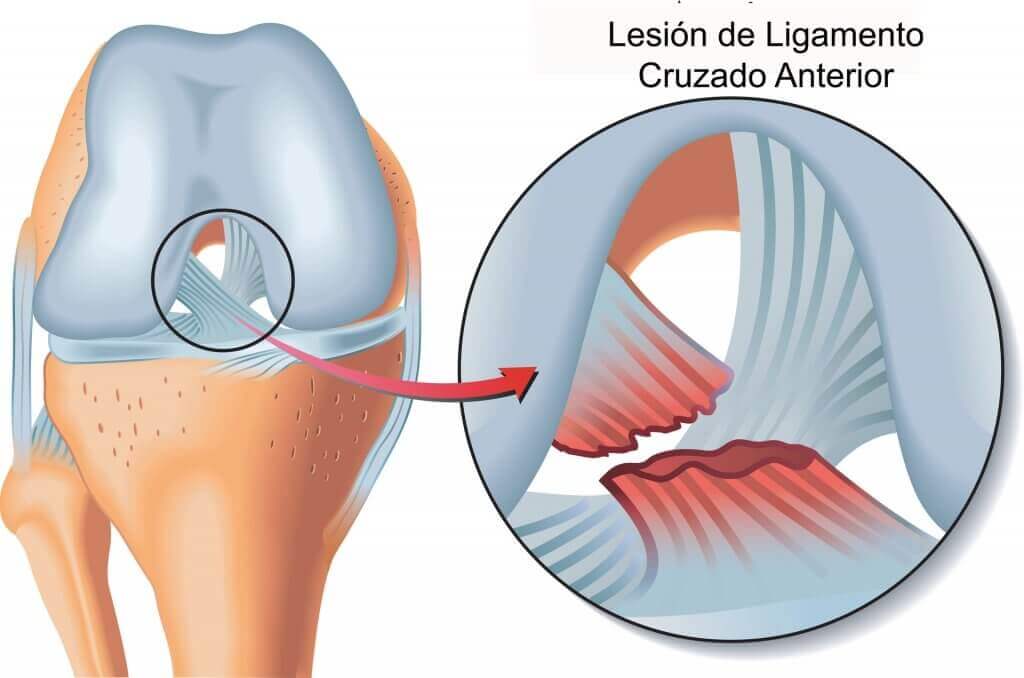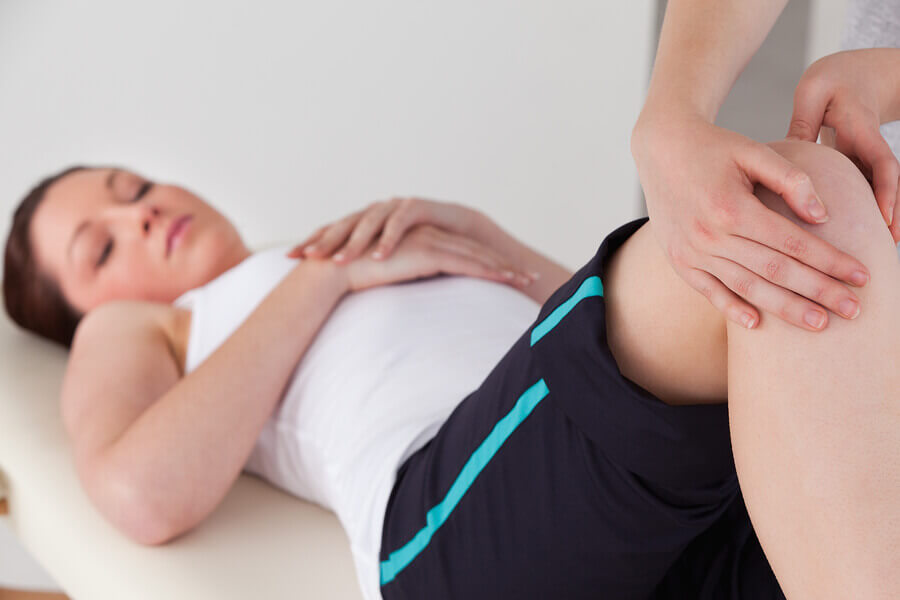Water Rehabilitation for Cruciate Ligament Injuries

The two ligaments that cross over your knee play a major role in stabilizing the joint. Tearing one of those ligaments means months of treatment and effort to reinstate normal, everyday life. One of the most effective methods for cruciate ligament injuries is water rehabilitation.
The knee ligaments
Ligaments are soft tissues that join together to stabilize bone structures. The knee has four ligaments that connect the femur with the tibia and fibula:
- Anterior cruciate ligament
- Posterior cruciate ligament
- Medial collateral ligament
- Lateral collateral ligament
The first two are located inside the knee joint while the last two are outside on the inner and outer face. In our post today, we’ll just focus on the first two ligaments.
The cruciate ligaments
If you play a sport, you’ve probably heard about a case of a torn cruciate ligament at some point. It’s one of the worst injuries that professional athletes can face as it affects the stability of such an important joint.
While these ligaments can stretch and return to their normal state, pushing them past their limits or sudden movements without warming them up can lead to injury. Most cases of cruciate ligaments unfold when a person turns their knee while their foot still planted on the ground. Or, ligaments can suffer when a runner comes to a sudden stop, or when someone suffers a strong hit or tackle.

The ligaments can’t withstand the excessive force and tear. Depending on the intensity of the injury, the results can vary between a grade one, two or three sprain.
Grade one sprains consist of distention while grade two sprains have partial or total rupture of the ligament. Lastly, grade three sprains indicate a complete rupture along with bone displacement. Each grade of sprain has a certain recovery time, possibilities of recuperation and repercussions.
Rehabilitation for cruciate ligaments
Rehabilitation for cruciate ligaments always addresses reducing pain and swelling first, which is a process known as RICE:
- Rest: Resting the joint and avoiding any kind of activity that involves using it.
- Ice: Applying cold temperatures to contain swelling.
- Compression: Compressing the joint to support and keep the joint in place.
- Elevation: Lifting the leg above the heart helps circulation, thus reducing swelling in the affected area.
After RICE, the treatments differ depending on the grade of the injury. In some cases, grades two and three may even require surgery.
Once their knee can support activity again, patients can embark on several rehab plans that encompass various types of exercises. As they get stronger, they tackle higher intensities in order to recuperate their knee as much as possible.
But before reaching that point in physical rehab, the initial phases of rehab don’t seem to make much sense. If you still can’t stand on your leg, how can you even exercise the joint in the first place?
Water rehabilitation for cruciate ligaments
Water exercises are a great solution. Aside from offering a space that reduces the effects of gravity, water lightly compresses body parts as well. In addition, setting the water at certain temperatures can also help patients relax.
Thus, water helps rehab patients grow stronger without harming their injury. Additionally, water rehab helps reduce swelling and pain.
In the water, patients can do exercises that focus on specific muscles or others that work out an entire set. You can even bike, walk or run in the water. Whatever you choose to do, you can get your knee in motion, which is essential for recovery.
In rehab cases for cruciate ligaments, patients should work on flexions and extensions as well as walking normally again. They also should complete proprioception or balance exercises.

In order to meet those goals, flexing and extending the knee, walking and running normally (after a few weeks), biking or mounting something that challenges your balance in the water will serve as great rehab.
We also want to highlight that practicing these activities in the water is only recommendable in the initial stages of rehabilitation. When your body is strong enough, practicing them on land will yield more effective results. Remember, we’re not fish; our normal everyday life takes place on land and, when able, you have to help your body readjust to it.
To wrap up, don’t keep your knee out-of-use for too long. Instead, start teaching your knee how to move again. Water rehabilitation is a wonderful way to begin.
The two ligaments that cross over your knee play a major role in stabilizing the joint. Tearing one of those ligaments means months of treatment and effort to reinstate normal, everyday life. One of the most effective methods for cruciate ligament injuries is water rehabilitation.
The knee ligaments
Ligaments are soft tissues that join together to stabilize bone structures. The knee has four ligaments that connect the femur with the tibia and fibula:
- Anterior cruciate ligament
- Posterior cruciate ligament
- Medial collateral ligament
- Lateral collateral ligament
The first two are located inside the knee joint while the last two are outside on the inner and outer face. In our post today, we’ll just focus on the first two ligaments.
The cruciate ligaments
If you play a sport, you’ve probably heard about a case of a torn cruciate ligament at some point. It’s one of the worst injuries that professional athletes can face as it affects the stability of such an important joint.
While these ligaments can stretch and return to their normal state, pushing them past their limits or sudden movements without warming them up can lead to injury. Most cases of cruciate ligaments unfold when a person turns their knee while their foot still planted on the ground. Or, ligaments can suffer when a runner comes to a sudden stop, or when someone suffers a strong hit or tackle.

The ligaments can’t withstand the excessive force and tear. Depending on the intensity of the injury, the results can vary between a grade one, two or three sprain.
Grade one sprains consist of distention while grade two sprains have partial or total rupture of the ligament. Lastly, grade three sprains indicate a complete rupture along with bone displacement. Each grade of sprain has a certain recovery time, possibilities of recuperation and repercussions.
Rehabilitation for cruciate ligaments
Rehabilitation for cruciate ligaments always addresses reducing pain and swelling first, which is a process known as RICE:
- Rest: Resting the joint and avoiding any kind of activity that involves using it.
- Ice: Applying cold temperatures to contain swelling.
- Compression: Compressing the joint to support and keep the joint in place.
- Elevation: Lifting the leg above the heart helps circulation, thus reducing swelling in the affected area.
After RICE, the treatments differ depending on the grade of the injury. In some cases, grades two and three may even require surgery.
Once their knee can support activity again, patients can embark on several rehab plans that encompass various types of exercises. As they get stronger, they tackle higher intensities in order to recuperate their knee as much as possible.
But before reaching that point in physical rehab, the initial phases of rehab don’t seem to make much sense. If you still can’t stand on your leg, how can you even exercise the joint in the first place?
Water rehabilitation for cruciate ligaments
Water exercises are a great solution. Aside from offering a space that reduces the effects of gravity, water lightly compresses body parts as well. In addition, setting the water at certain temperatures can also help patients relax.
Thus, water helps rehab patients grow stronger without harming their injury. Additionally, water rehab helps reduce swelling and pain.
In the water, patients can do exercises that focus on specific muscles or others that work out an entire set. You can even bike, walk or run in the water. Whatever you choose to do, you can get your knee in motion, which is essential for recovery.
In rehab cases for cruciate ligaments, patients should work on flexions and extensions as well as walking normally again. They also should complete proprioception or balance exercises.

In order to meet those goals, flexing and extending the knee, walking and running normally (after a few weeks), biking or mounting something that challenges your balance in the water will serve as great rehab.
We also want to highlight that practicing these activities in the water is only recommendable in the initial stages of rehabilitation. When your body is strong enough, practicing them on land will yield more effective results. Remember, we’re not fish; our normal everyday life takes place on land and, when able, you have to help your body readjust to it.
To wrap up, don’t keep your knee out-of-use for too long. Instead, start teaching your knee how to move again. Water rehabilitation is a wonderful way to begin.
All cited sources were thoroughly reviewed by our team to ensure their quality, reliability, currency, and validity. The bibliography of this article was considered reliable and of academic or scientific accuracy.
- Effectiveness of Aquatic Exercise in Improving Lower Limb Strength in Musculoskeletal Conditions: A Systematic Review and Meta-Analysis. Heywood, Sophie et al. Archives of Physical Medicine and Rehabilitation, Volume 98, Issue 1, 173 – 186
- Tratamiento hidrocinesiterápico de la rotura parcial del ligamento cruzado anterior de la rodilla. A propósito de un caso. I.Díaz Pallarés, M.González Pisano. Fisioterapia, Volume 36, Issue 2.
- Huamaní Carrasco, E. (2016). Recuperación de la fuerza muscular del cuádriceps en pacientes posoperados de ligamento cruzado anterior, en un plazo de tres meses – Centro Médico Naval “Cirujano Mayor Santiago Távara”. Licenciatura. Universidad Nacional Mayor de San Marcos.
This text is provided for informational purposes only and does not replace consultation with a professional. If in doubt, consult your specialist.








